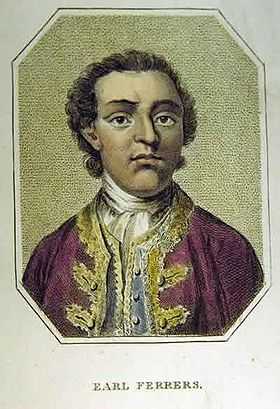Laurence Shirley, 4th Earl Ferrers

Laurence Shirley, 4th Earl Ferrers (18 August 1720 – 5 May 1760) was an English nobleman, notable for being the last peer to be hanged, following his conviction for murdering his steward.
Biography
Lord Ferrers, descendant of an ancient and noble family, was the eldest son of the Honourable Laurence Ferrers, himself the third son of the first Earl Ferrers. At the age of twenty, he quit his estates and Oxford education, and began living a debauched life in Paris. At the age of twenty-five he inherited his title from his insane uncle the 3rd Earl Ferrers, and with it estates in Leicestershire, Derbyshire and Northamptonshire. He lived, however, at Staunton Harold Hall in northwest Leicestershire. In 1752, he married Mary, the youngest sister of Sir William Meredith, 3rd Baronet.[1][2] Ferrers was also a cousin to Selina, Countess of Huntingdon, the prominent Methodist lady and supporter of George Whitefield, though he was not involved in the Methodist revival.
Marriage troubles
It was said that there was insanity in his family, and from an early age his behaviour seems to have been eccentric, and his temper violent, though he was quite capable of managing his business affairs. Significantly, in 1758, his wife obtained a separation from him for cruelty, which would have been extremely rare for the time. She was said to be extremely pretty and clearly did not appreciate her husband's drinking, womanising and the fact that he had a mistress and children. The old family steward (see after) was murdered, it would seem, because he may have given evidence on Mary's behalf and was afterwards taxed with collecting rents due to her. She was married again, on 28 March 1769, to Lord Frederick Campbell. Mary later died in a fire at her country seat, Coomb Bank, Kent, on 25 July 1807.[3]
Murder
The Ferrers' estates were then vested in trustees; Ferrers secured the appointment of an old family steward named Johnson, as receiver of rents. This man faithfully performed his duty as a servant to the trustees, and did not prove amenable to Ferrers' personal wishes. On 18 January 1760, Johnson called at the earl's mansion at Staunton Harold, Leicestershire, by appointment, and was directed to his lordship's study. Here, after some business conversation, Lord Ferrers shot him. Johnson didn't die immediately, but instead was given some treatment at the hall followed by continued verbal abuse from a drunken Ferrers before a Dr. Kirkland was able to convey him to his own home where he died the following morning.[4]
In the following April Ferrers was tried for murder by his peers in Westminster Hall, Attorney General Lord Camden leading for the prosecution.[5] Shirley's defence, which he conducted in person with great ability, was a plea of insanity, and it was supported by considerable evidence, but he was found guilty. According to Lord Oxford, "Lord Ferrers was not mad enough to be struck with Lady Huntingdon's sermons. The Methodists have nothing to brag of his conversion, though Whitefield prayed for him." Ferrers subsequently said that he had only pleaded insanity to oblige his family, and that he had himself always been ashamed of such a defence.[6]
Execution
On 5 May 1760, dressed in a light-coloured suit embroidered with silver (the outfit he had worn at his wedding), he was taken in his own carriage from the Tower of London to Tyburn and there hanged by Thomas Turlis.[7] There are several illustrations of the hanging. It has been said that as a concession to his rank the rope used was of silk. After the execution his body was taken to Surgeon's Hall for public exhibition and dissection. The Execution was widely publicised in popular culture as evidence of equality of the law and the story of a wicked nobleman who was executed "like a common criminal" was told well into the 1800s.
Notes
- ↑ "Earl Ferrers". capitalpunishmentuk.org. Retrieved 18 March 2015.
- ↑ "Mary Meredith". ThePeerage.com. Retrieved 18 March 2015.
- ↑ Hamilton 1886, p. 195.
- ↑ "Earl Ferrers". CapitalPunishmentUK.org. Retrieved 18 March 2015.
- ↑ Thomas 2008.
- ↑ Kaufman-Osborn 2002, p. 77.
References
 Hamilton, John Andrew (1886). "Campbell, Frederick (1729-1816)". In Stephen, Leslie. Dictionary of National Biography 8. London: Smith, Elder & Co. p. 357.
Hamilton, John Andrew (1886). "Campbell, Frederick (1729-1816)". In Stephen, Leslie. Dictionary of National Biography 8. London: Smith, Elder & Co. p. 357. - Kaufman-Osborn, Timothy Vance (2002). From noose to needle: capital punishment and the late liberal state. Law, meaning, and violence. University of Michigan Press. p. 77. ISBN 0-472-08890-4.
- Thomas, P. D. G. (2008). "Pratt, Charles, first Earl Camden (1714–1794)". Oxford Dictionary of National Biography (online ed.). Oxford University Press. doi:10.1093/ref:odnb/22699. (Subscription or UK public library membership required.)
19 Howell's State Trials may be downloaded from https://books.google.com/books?id=5aIrAQAAMAAJ&pg=PT474&dq=howell+state+trials+ferrers+xix&hl=en&sa=X&ei=Ioq2VKTGB63hsASlzICgAQ&ved=0CC8Q6AEwAw#v=onepage&q=howell%20state%20trials%20ferrers%20xix&f=false
Further reading
 This article incorporates text from a publication now in the public domain: Chisholm, Hugh, ed. (1911). "Ferrers, Laurence Shirley, 4th Earl". Encyclopædia Britannica (11th ed.). Cambridge University Press.
This article incorporates text from a publication now in the public domain: Chisholm, Hugh, ed. (1911). "Ferrers, Laurence Shirley, 4th Earl". Encyclopædia Britannica (11th ed.). Cambridge University Press. Chisholm, Hugh, ed. (1911). "Ferrers, Laurence Shirley". Encyclopædia Britannica 10 (11th ed.). Cambridge University Press. p. 287.
Chisholm, Hugh, ed. (1911). "Ferrers, Laurence Shirley". Encyclopædia Britannica 10 (11th ed.). Cambridge University Press. p. 287.- The Newgate Calendar: LAURENCE, EARL FERRERS
- Tamworth Herald: The murderous Earl Ferrers
- Burke, Peter (1849). "The Trial of Earl Ferrers". Celebrated Trials connected with the Aristocracy in the Relations of Private Life. London: William Benning & Cp. pp. 193–227.
- Walford, Edward (1890). "Laurence, Earl Ferrers". Tales of our Great Families. London: Chatto & Windus. pp. 50–63.
| Peerage of Great Britain | ||
|---|---|---|
| Preceded by Henry Shirley |
Earl Ferrers 1745–1760 |
Succeeded by Washington Shirley |
|